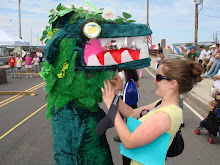Tuesday, March 30, 2010
Citizens Make the Vision for their Communities
Nice video about people getting active to help their communities. The first section about Make the Road shares the stories of a few individuals working together to make sure that their neighbors have a better, more positive life in the neighborhood where they live. The video is sponsored by Bank of America as part of their Citizen Active series - getting citizens involved in their communities to work for positive change.
Friday, March 12, 2010
Earth Hour brings 100 countries together
Earth Hour is coming up in a few weeks - this year it's on March 27th at 8:30 PM wherever you are. The citizens from 100 participating countries voluntarily turn off their lights for 60-minutes in the world's largest collective event as a symbol that we are ready for action on climate change. The video below explains the event - pretty impressive to see the lights go out around the world, especially the spotlights on the sphinx and pyramids in Egypt.
Wednesday, March 10, 2010
Personalized Energy Production that Mimics Nature
Anyone working in renewable energy production, international development, or climate change related fields should know the name and ideas of Dan Nocera. Dr. Nocera was a guest lecturer in a course I took last fall, and is possibly one of the sharpest, most intelligent speakers I've ever seen. In his lab at MIT, he's developing a household-sized energy system that collects solar energy, uses the energy to split water into hydrogen and oxygen, which is then used as fuel for a hydrogen fuel cell battery. And the battery then produces clean water as its byproduct.
The other cool idea that Nocera addresses is that if you want to take a large, centralized system and make it decentralized (in this case electricity), you can't just take the same machine or method and make it smaller, because the cost will go way up. Instead, you have to redesign the system from scratch with the perspective of making something small and inexepensive.
This is the guy who tells people like Putin and T-Boone Pickins when their numbers are wrong - check it.
The other cool idea that Nocera addresses is that if you want to take a large, centralized system and make it decentralized (in this case electricity), you can't just take the same machine or method and make it smaller, because the cost will go way up. Instead, you have to redesign the system from scratch with the perspective of making something small and inexepensive.
This is the guy who tells people like Putin and T-Boone Pickins when their numbers are wrong - check it.
Dan Nocera: Personalized Energy from PopTech on Vimeo.
Monday, March 1, 2010
What is the soul of a community?
 What do we love most about our communities? Gallup, in collaboration with the Knight Foundation surveyed almost 28,000 Americans to pinpoint what makes a community a great place to live. So what are the top three?
What do we love most about our communities? Gallup, in collaboration with the Knight Foundation surveyed almost 28,000 Americans to pinpoint what makes a community a great place to live. So what are the top three?1. Openness
2. Social Offerings
3. Aesthetics
Aesthetics is in the top three! This is huge. The first two speak to the fact that humans are naturally social. Being part of a group has been good to us for thousands of years, and we still look for those connections today. But the third (third!) on the list is about looks -- we love living in a place that looks good. This reaffirms the idea that we are visual creatures; our daily lives are impacted by how things look around us. We make value decisions based on
 attractive settings, including both natural beauty (mountains, ocean, rivers) and enhanced beauty (art, gardens, trees, parks, architecture).
attractive settings, including both natural beauty (mountains, ocean, rivers) and enhanced beauty (art, gardens, trees, parks, architecture).Philadelphia realized this in the mid 80's and started the Philadelphia Mural Arts Project. While the city wasn't able to change their buildings and infrastructure overnight, they decided to invest significantly to have local artists paint murals around the city - a way of improving local aesthetics and reflecting the community's vision for the future. Now they give city-wide tours of their program, creating a tourist draw, and local jobs. The Village for Arts and Humanities in north Philadelphia also recognized the individual's need to be tied to the aesthetics of their neighborhood through murals and green spaces. There are thousands of examples of this throughout the U.S. but this recent research launches aesthetics onto a new level of importance for successful communities. If we want to make communities where people want to live, then encouraging openness, social offerings, and great aesthetics puts us on that path.
A more detailed explanation of the these findings can be found on the Soul of the Community website and blog.
Subscribe to:
Posts (Atom)


